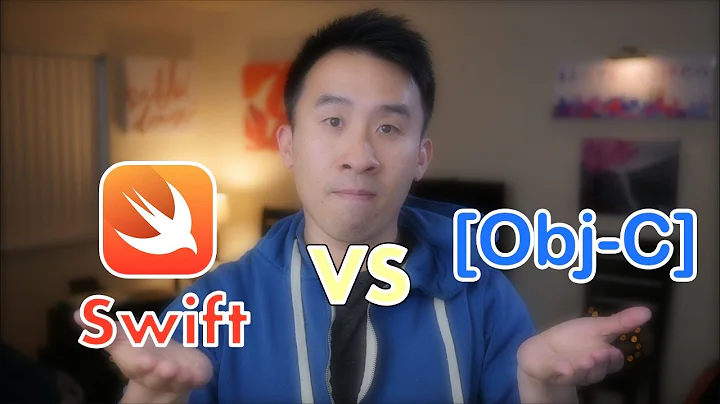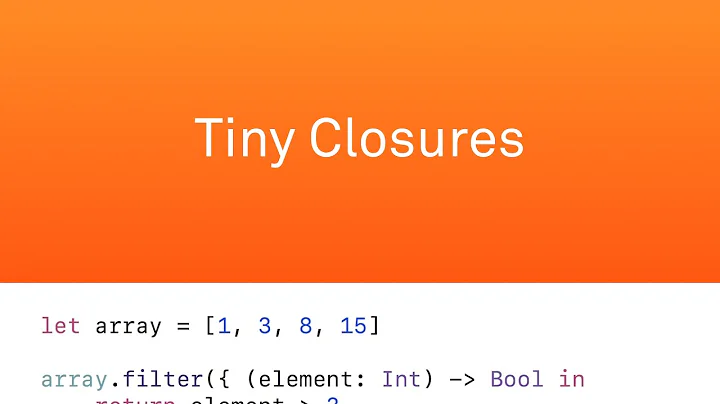When @objc and @nonobjc write before method and variable in swift?
Solution 1
This is explained in the Apple's official documentation about Objective-C - Swift interoperability:
When you use the @objc(name) attribute on a Swift class, the class is made available in Objective-C without any namespacing. As a result, this attribute can also be useful when migrating an archivable Objective-C class to Swift. Because archived objects store the name of their class in the archive, you should use the @objc(name) attribute to specify the same name as your Objective-C class so that older archives can be unarchived by your new Swift class.
Conversely, Swift also provides the @nonobjc attribute, which makes a Swift declaration unavailable in Objective-C. You can use it to resolve circularity for bridging methods and to allow overloading of methods for classes imported by Objective-C. If an Objective-C method is overridden by a Swift method that cannot be represented in Objective-C, such as by specifying a parameter to be a variable, that method must be marked @nonobjc.
To summarize, use @objc when you want to expose a Swift attribute to Objective-C without a namespace . Use @nonobjc if you want to keep the attribute available and accessible only in Swift code.
Solution 2
(Addendum/additional official details to @bontoJR well summarizing answer)
From the Swift Language Reference - Attributes [emphasis mine]:
objcApply this attribute to any declaration that can be represented in Objective-C — for example, non-nested classes, protocols, nongeneric enumerations (constrained to integer raw-value types), properties and methods (including getters and setters) of classes and protocols, initializers, deinitializers, and subscripts. The
objcattribute tells the compiler that a declaration is available to use in Objective-C code....
nonobjcApply this attribute to a method, property, subscript, or initializer declaration to suppress an implicit
objcattribute. Thenonobjcattribute tells the compiler to make the declaration unavailable in Objective-C code, even though it is possible to represent it in Objective-C....
Solution 3
Here you can find more details in this Swift Documentation : InteractingWithObjective-C
As an answer of your question, overview from attached link is as below.
@objc : You can use attribute to change the name of a class, property, method, enumeration type, or enumeration case declaration in your interface as it’s exposed to Objective-C code.
Example : if the name of your Swift class contains a character that isn’t supported by Objective-C, you can provide an alternative name to use in Objective-C.
@nonobjc : It makes a swift declaration unavailable in Objective-C. You can use it to resolve circularity for bridging methods and to allow overloading of methods for classes imported by Objective-C.
Related videos on Youtube
vikas prajapati
Learning iOS,andriod,flutter,SwiftUI,watchOS,tvOS,macOS...
Updated on June 04, 2022Comments
-
 vikas prajapati almost 2 years
vikas prajapati almost 2 yearsWhen I declare
staticparameter in extension of class then I have to write@nonobjcbefore variable like:@nonobjc static let test = "test"and sometimes I have to write
@objcbefore method, so what is use of@objcand@nonobjcin Swift.Can anyone help me for this problem?
-
 dfrib over 7 years
dfrib over 7 years
-
-
Alessandro Martin almost 6 yearsIsn't this now limited to "overriding" the
@objcMembersannotation of a class when declaring an extension we don't want to expose to Objective-C?








![Lightweight migration in core data tutorial swift iOS in Hindi [English Subtitles]](https://i.ytimg.com/vi/YPEX9twI-zU/hq720.jpg?sqp=-oaymwEcCNAFEJQDSFXyq4qpAw4IARUAAIhCGAFwAcABBg==&rs=AOn4CLAKhj7WlSEZr-TyccMbAEj0rk0HEg)



